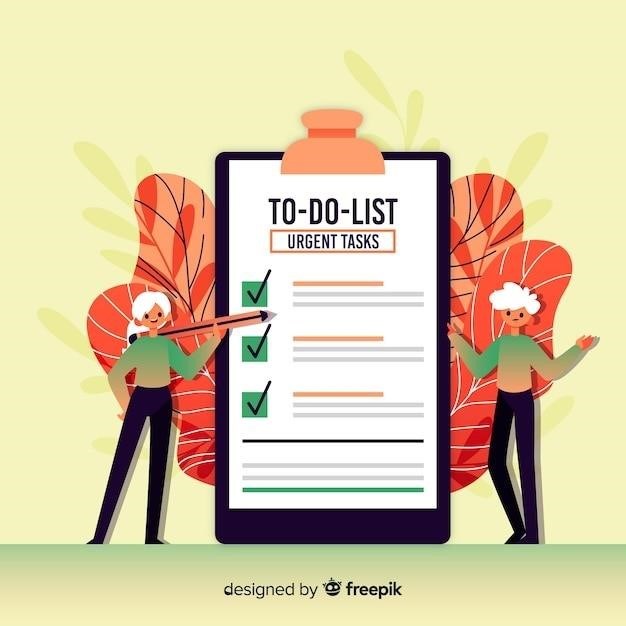Final Walk-Through Checklist⁚ A Guide for Homebuyers
A final walk-through is a crucial step in the home buying process, allowing you to verify that the property is in the condition you agreed upon before closing. This checklist will guide you through the essential aspects to inspect and ensure a smooth transition into your new home.
Introduction
The final walk-through is a critical step in the home buying process, often occurring just a few days before closing. This crucial inspection allows you, the buyer, to ensure that the property is in the condition you agreed upon in the purchase agreement. It’s your last chance to identify any outstanding issues, confirm that agreed-upon repairs have been completed, and verify that all fixtures and appliances are in working order. This step is essential to avoid surprises and ensure a smooth transition into your new home. You should take a thorough look at the property, paying close attention to details such as appliances, interior spaces, and exterior components. Don’t hesitate to document any discrepancies or concerns you find during the inspection. Taking the time to thoroughly examine the property during the final walk-through helps you gain peace of mind and ensures a positive closing experience.
Purpose of the Final Walk-Through
The final walk-through serves as a comprehensive inspection of the property, allowing you to verify that it meets the agreed-upon conditions before closing. It provides a final opportunity to assess the property’s condition and address any concerns you may have. The primary goal is to ensure that the property is in the same condition as when it was initially inspected and that all agreed-upon repairs or changes have been completed. Additionally, the walk-through aims to identify any new issues that may have arisen since the initial inspection, such as damage, missing items, or unaddressed maintenance needs. This final check helps prevent any surprises or disagreements during the closing process, allowing for a smooth and positive transition into your new home.
What to Bring to the Final Walk-Through
To ensure a thorough and efficient final walk-through, it’s essential to come prepared with the right tools and documents. Here’s a list of items to bring⁚
- Final Walk-Through Checklist⁚ Bring a printed copy of your checklist to keep track of everything you need to inspect. This will help you stay organized and ensure you don’t miss anything.
- Copy of the Purchase Agreement⁚ This document outlines the agreed-upon terms of the sale, including any specific items that should be included with the property.
- Inspection Reports⁚ Review your home inspection report and any other relevant reports from your due diligence period to compare the property’s current state to the initial findings.
- Camera or Smartphone⁚ Use a camera or your smartphone to document any issues or discrepancies you encounter during the walk-through. Taking pictures provides valuable evidence in case of any disputes later on.
- Notepad and Pen⁚ Use a notepad and pen to jot down any observations, questions, or concerns that arise during the walk-through.
- Flashlight⁚ A flashlight will be helpful for inspecting areas with limited lighting, such as closets, basements, or attics.
- Measuring Tape⁚ A measuring tape can be useful for verifying the dimensions of rooms or other areas of the property.
Having these items at hand will ensure you’re well-equipped to conduct a thorough final walk-through and document any necessary details.
Appliances
Appliances are a significant investment in any home, and it’s crucial to ensure they are in working order before closing. Here’s a checklist for inspecting appliances⁚
- Stove/Oven: Turn on all burners and the oven to check for proper functionality. Verify that all elements heat up evenly and that the oven reaches the desired temperature.
- Refrigerator/Freezer: Ensure the refrigerator and freezer are cooling properly. Check for any unusual noises or leaks.
- Dishwasher⁚ Run a cycle of the dishwasher to verify that it’s washing, rinsing, and drying dishes effectively.
- Microwave⁚ Test the microwave by heating a cup of water to ensure it’s functioning correctly.
- Garbage Disposal⁚ Run the garbage disposal with cold water to check for any unusual noises or grinding issues.
- Washing Machine and Dryer⁚ Run a cycle of the washing machine and dryer to confirm they are operating properly. Check for any leaks or unusual noises.
If you discover any issues with appliances during the final walk-through, document them with photographs and make a note of them in your checklist.
Interior Spaces
A thorough inspection of the interior spaces is essential to ensure the house is in the condition you expected. Here’s a checklist for inspecting the interior⁚
- Flooring⁚ Check for any damage, scratches, or unevenness in the flooring throughout the house.
- Walls and Ceilings⁚ Inspect walls and ceilings for any cracks, water damage, or stains.
- Windows and Doors⁚ Check that all windows and doors open and close properly. Ensure there are no drafts or leaks.
- Cabinets and Drawers⁚ Open and close all cabinets and drawers to ensure they function smoothly. Check for any damage or wear and tear.
- Lighting⁚ Turn on all light fixtures and switches to verify that they are working.
- Plumbing⁚ Run the faucets in all sinks and showers to check for water pressure and leaks. Flush all toilets to ensure they function correctly.
- Heating and Cooling⁚ If the season allows, turn on the heating and cooling systems to check that they are operational.
If you notice any issues, document them with photographs and make a note of them in your checklist.
Exterior Components
A thorough inspection of the exterior is crucial to ensure the home’s structural integrity and safety. This checklist will help you examine key exterior components⁚
- Roof⁚ Check for any missing or damaged shingles, leaks, or signs of water damage.
- Gutters and Downspouts⁚ Ensure gutters are clean and free of debris and that downspouts direct water away from the foundation.
- Siding⁚ Inspect the siding for any cracks, loose boards, or damage from weather.
- Windows and Doors⁚ Check that all exterior windows and doors are secure, open and close properly, and have no leaks or drafts;
- Foundation⁚ Look for any cracks, crumbling, or signs of water damage in the foundation.
- Driveway and Walkways⁚ Inspect the driveway and walkways for cracks, uneven surfaces, or loose paving stones.
- Landscaping⁚ Check for any dead or dying trees, shrubs, or plants that may pose a hazard or require attention.
Document any issues with photographs and note them in your checklist.
General Items to Check
Beyond specific appliances and areas, there are general items to check that are often overlooked during a final walk-through. These ensure the overall functionality and safety of the home.
- Smoke Detectors and Carbon Monoxide Detectors⁚ Check that all smoke detectors and carbon monoxide detectors are installed and in working order.
- Fire Extinguishers⁚ Verify that fire extinguishers are present and easily accessible.
- Security System⁚ If the home has a security system, make sure it is functioning properly and the alarm panel is accessible.
- Water Heater⁚ Check the water heater for any leaks or signs of corrosion.
- Electrical Outlets and Switches⁚ Ensure that all electrical outlets and switches function properly and are not loose or damaged.
- Plumbing Fixtures⁚ Inspect faucets, toilets, and showers for any leaks or signs of water damage.
- Attic and Basement⁚ If possible, take a quick look at the attic and basement for any signs of water damage, pests, or structural issues.
Document any concerns or issues with photographs and make sure to note them in your checklist.
Documentation and Reporting
Proper documentation is essential during a final walk-through. It ensures that any issues or discrepancies are recorded and can be addressed before closing. Here’s how to effectively document and report your findings⁚
- Checklist⁚ Use a comprehensive checklist to document your inspection. Include specific details about each item, such as model numbers, serial numbers, and any observed defects.
- Photographs⁚ Take clear and detailed photographs of any issues you encounter. This provides visual evidence for future reference.
- Notes⁚ Write down any observations, concerns, or questions you have during the walk-through. Be as detailed as possible.
- Reporting⁚ After the walk-through, create a report summarizing your findings. Include the date, time, and location of the inspection, as well as a list of all issues identified.
- Communication⁚ Communicate your findings to your real estate agent or attorney promptly. They can help you resolve any issues before closing.
Keep a copy of your checklist, photographs, and report for your records. This will help you track any outstanding issues and ensure a smooth transition into your new home.
Tips for a Successful Final Walk-Through
A final walk-through is your last chance to assess the property before closing. To make this process as smooth as possible, keep these tips in mind⁚
- Schedule in Advance⁚ Schedule your walk-through well in advance of closing. Typically, two to three days before closing is ideal.
- Bring a Checklist⁚ Have a comprehensive checklist ready, covering all aspects of the property, from appliances to exterior components.
- Take Your Time⁚ Don’t rush through the walk-through. Thoroughly inspect every room, closet, and outdoor space.
- Be Objective⁚ Try to be objective in your assessment. Don’t let minor imperfections derail the entire process.
- Document Everything⁚ Take photographs and detailed notes of any issues you find. This will be invaluable if you need to address them before closing.
- Communicate with Your Agent⁚ If you encounter any major problems, immediately contact your real estate agent or attorney. They can help you negotiate with the seller.
A successful final walk-through ensures a smooth closing process and a satisfying transition into your new home. By following these tips, you can confidently navigate this essential step in the home buying journey.
The final walk-through is an essential step in the home buying process. It allows you to verify that the property is in the condition you agreed upon and to identify any potential issues before closing. By using a comprehensive checklist and following the tips outlined in this guide, you can ensure a smooth and successful transition into your new home.
Remember, this checklist is a guide. You may need to adapt it to suit the specific circumstances of your purchase. It’s crucial to communicate with your real estate agent or attorney if you encounter any significant problems. Be prepared to negotiate with the seller to address any outstanding issues.
Ultimately, a thorough final walk-through gives you peace of mind and protects your investment. It ensures that you are getting what you paid for and that your new home is ready for you to enjoy.
Resources
For further information and resources on final walk-throughs, you can consult the following websites and organizations⁚

- InspectorSeek.com⁚ This website offers a wealth of information on home inspections, including a downloadable final walk-through checklist. They also provide tips on creating electronic signatures for inspection forms.
- pdfFiller⁚ This platform provides a comprehensive final walk-through checklist form. It covers various aspects of the property, including appliances, interior spaces, and exterior components.
- Heartland Inspections⁚ This company offers a downloadable pre-closing walk-through checklist that can be used to prepare for your final walk-through.
- Nationwide⁚ This insurance company provides helpful articles and tips on various aspects of homeownership, including final walk-throughs.
- Real Estate Agents and Attorneys⁚ Your real estate agent and attorney are valuable resources for guidance and support during the final walk-through process. They can help you understand your rights and obligations and ensure a smooth closing.
Remember, using these resources can enhance your understanding of the final walk-through process and equip you with the necessary tools for a successful closing.
